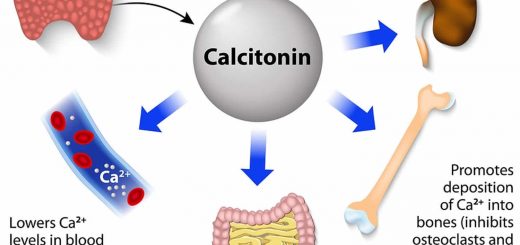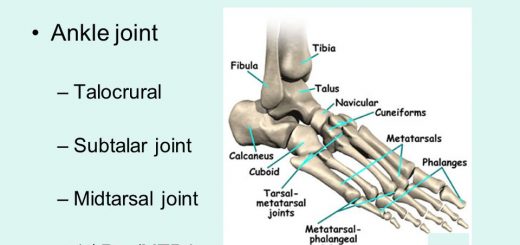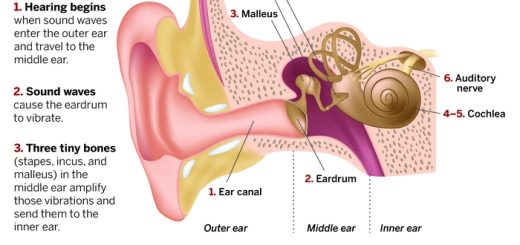Physiology of equilibrium, Hearing, ear balance, Function and Stimulants of Semicircular canals
Human ears detect sounds, and they maintain balance, The receptors for two sensory modalities (hearing and equilibrium) are housed in the ear, Hearing & equilibrium depend on the hair cells, two types of equilibrium are static (gravitational) equilibrium, and dynamic (rotational) equilibrium, Static equilibrium involves the movement of the head with respect to gravity and dynamic equilibrium involves the acceleration of the head in rotation, horizontal, and vertical movements.
Mechanism of action of the macula
The hair cells of the macula act as stretch receptors that are stimulated by a stretch. They are stretched when their kinocilia become bent secondary to the displacement of the otoliths (otoconia). Once the hair cells become stretched they become depolarized and discharge impulses along vestibular nerve endings.
Functions of the utricle and saccule
1. Orientation of the head position relative to gravity
If the head is in a central position, the hair cells in both maculae are exposed to uniform stretch resulting in equal discharge from maculae on both sides. This discharge on reaching the cerebral cortex will give the sense of the erect position of the head.
If the head is tilted to the right side, there will be displacement of the otoconia to the right side with bending of the cilia of both maculae towards the right. However, the bending in the right macula is more than in the left, resulting in unequal discharge from both maculae that when reaching the cortex will give the sense of right tilt of the head.
2. Perception of linear acceleration
Sudden forward horizontal movement leads to a sense of back fall. This can be explained by that the otoconia become displaced backward due to their inertia stretching all the hair cells of both maculae, leading to an increase in the discharge of the vestibular nerve that reaches the cortex giving the sense of back fall. Corrective movements are initiated by the cortex to support the body by leaning forward.
The macula of the utricle helps to orient the head position in the erect posture and responds to horizontal linear acceleration. The macula of the saccule is important in equilibrium when the person is lying down or swimming, It also responds to vertical linear acceleration.
Mechanism of action of the crista ampullaris
When the stereocilia are bent in the direction of the kinocilium the hair cells become depolarized and start to discharge impulses along the vestibular nerve fibers. Conversely, if the stereocilia become displaced away from the kinocilium, the hair cells become hyperpolarized and stop discharging.
In case of the horizontal SCC, the kinocilium lies towards the utricle, while in case of superior or posterior SCC, the kinocilium lies towards the canal that is to say if the cupula of the horizontal canal becomes displaced towards the utricle, the crista becomes stimulated, white if the cupula of the superior or posterior SCC is deviated towards the utricle, the crista becomes inhibited.
Functions of the semicircular canals
- Detection of angular acceleration and deceleration of the head (rotation).
- Initiation of the appropriate reflexes that maintain equilibrium during rotation. (vestibulo-spinal reflexes).
- Stabilizes the visual field during head movement (vestibulocular reflex).
Mode of action of SCCs during rotation
At rest, both cupulae of the right and left horizontal SCCs are central with equal bilateral discharge, giving no sense of rotation. When the individual starts to rotate in a horizontal plane from left to right, the endolymph lags behind the moving canals due to its inertia.
In this case, the endolymph moves from right to left (opposite to the direction of rotation) deviating the right cupula towards the utricle i.e. stimulating the hair cells in the right crista ampullaris, while the left cupula deviates away from the utricle so that the left crista ampullaris is inhibited.
This will lead to an increased rate of discharge from the right side which on reaching the cortex gives a sense of rotation from left to right. 30 seconds after the onset of rotation the endolymph acquires the original direction of rotation from left to right, so both cupulae return central again by their elasticity, so there will be equal bilateral discharge with loss of sense of rotation.
At the stop of rotation, the endolymph continues to move from left to right by its momentum leading to stimulation of the left crista with inhibition of the right one. The unequal discharge, in this case, will give a sense of counter-rotation (the individual feels that he is rotating from right to left). This condition is called vertigo which is a false sense of counter-rotation in the absence of real rotation.
Within 30 seconds after rotation stops the endolymph stops moving and the cupula resumes their resting position by their elasticity, so their balanced discharge returns and the feeling of counter-rotation stops.
SCCs are active only at the beginning and end of the rotation or if the rate or direction of rotation is changed. Each SSC becomes activated when rotation is at its plane.
Stimulants of the semicircular canals
- Rotation (angular acceleration).
- Caloric stimulation: irrigation of the external ear with hot or cold water will lead to a change of temperature resulting in convection currents within the endolymph and stimulation of crista ampullaris.
- Galvanic stimulation: low voltage galvanic current applied to the mastoid process will lead to stimulation of the nerve endings in the crista ampullaris.
- Motion sickness: occurs in airplanes, and ships due to repetitive stimulation of the SCC with the movement developed in the endolymph.
- Labyrinthine disease as: labyrinthitis, vestibular neuritis.
- Meniere’s disease: patients with Meniere’s disease may have abrupt, recurrent, attacks of vertigo lasting minutes to hours. The vertigo may be accompanied by tinnitus (ringing in the ears) an ipsilateral sensori-neural hearing loss, nausea, vomiting, and a sensation of fullness or pressure in the ear. The disease results from the distension of the endolymph-filled spaces in the cochlear and vestibular parts of the labyrinth.
- Errors of refraction.
Central connections of the vestibular apparatus
Fibers of the vestibular nerve reach the vestibular ganglion then project to the 4 vestibular nuclei located in the upper medulla and lower pons (superior, lateral, medial, and inferior).
These nuclei project to several central targets; the cerebellum, the spinal cord (through the vestibulospinal tracts), the reticular formation, the nuclei of the Ill and VI cranial nerves as well as the thalamus. The nuclei of the Ill and VI cranial nerves are connected together through the medial longitudinal fasciculus (bundle).
Effects of stimulation of the semicircular canals
- Autonomic changes: Autonomic changes are in the form of nausea and vomiting, bradycardia, hypotension, and pallor as a result of stimulation of the reticular formation in the brainstem.
- Muscle tone changes: Increase muscle tone at the stimulated side, by the facilitatory discharge along the uncrossed medial and lateral vestibulospinal tracts together with the medial reticulospinal tract. Muscle tone on the opposite side is decreased due to the inhibitory discharge along the crossed lateral reticulospinal tract. These changes help to support the posture during rotation and guard against falling down toward the activated side.
- Vertigo: It is an abnormal perception of rotation that may involve either the subject or the external space. Vertigo is felt physiologically after rotation stops in an opposite direction to that of the original rotation, and pathologically in diseases of the labyrinth and vestibular nerve.
- Vestibulo-ocular reflex: It is a reflex of slow conjugate eye movements opposite to the direction of rotation to enable the eyes to remain focused on a stationary target when the head moves.
Neural pathway of vestibulo-ocular reflex
When the head turns to the right; the right crista fires impulses to the right vestibular nucleus, which in turn discharges to the right oculomotor and left abducent nuclei through the medial longitudinal bundle causing slow movement of both eyes opposite to the direction of rotation.
You can subscribe to Science Online on YouTube from this link: Science Online
You can download the Science Online application on Google Play from this link: Science Online Apps on Google Play
Ear anatomy, structure, function, Relations of middle ear & Action of Auditory muscles
Histological organization of vestibular apparatus, Hearing importance & body Equilibrium
Auditory system structure & function, Auditory apparatus, cochlea & cochlear duct
Hearing, Transmission of sound waves in Cochlea, Functions of Cochlea & Auditory pathway













